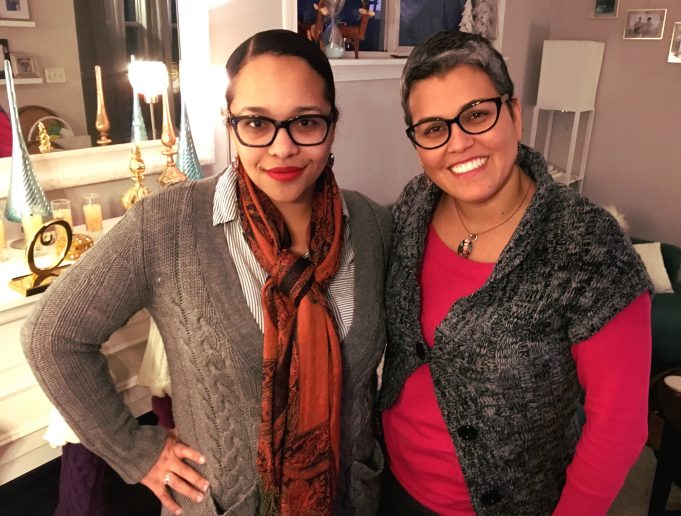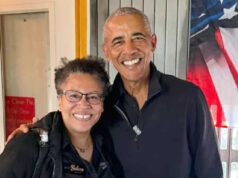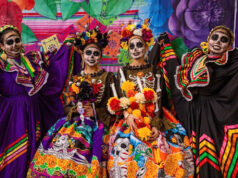“I think how we treat each other’s children defines who we are as a community,” says Ali Muldrow. “I think with the right leadership, Madison could be at the forefront of inclusion. I think my worst fear for Madison is that we get a little bit better and we think that this is improvement. We have the ability to aim so much higher and be a place where we treat one another well.
“We have the resources. We have the commitment of the community and we have the dedication of our families and our students. I think with all of that, we have the ability to do excellent work and to do exceptional things,” she adds. “I think it’s a matter of having the right people making decisions. You can’t have a school board that is afraid of change that also has the worst achievement gap in the country. That means that you are committed to maintaining and committing to and keeping the achievement gap.”
Muldrow, a parent, partner, writer, instructor, advocate, and doula who currently serves as co-executive director of the Gay Straight Alliance for Safe Schools (GSAFE), recently announced that she is throwing her hat into the ring, once again, for the Madison Metropolitan School District school board race. Two years ago, she ran an impressive campaign with thoughtful solutions to Madison’s racial disparities in education before losing to Kate Toews in the general election.
Still, that campaign was, in many ways, a lonely endeavor for her. Historically, Madison has elected very few women of color to positions of power whether it be City Council, Dane County Board or the MMSD school board. In fact, last year Gloria Reyes became the first women of color on the school board since Mary Wilburn in 1975. Betty Latimer, now known as Milele Chikasa Anana, was the first in 1974.

“For so many years, I hadn’t thought of women of color on the school board because I haven’t really seen particular representation of women of color – particularly women who are advocating around transformative work around education,” Muldrow tells Madison365. “A lot of times when I was doing forums or a series of events, I was not just the only black candidate, I was the only person of color in a room of 250 people. That is a really hard thing to grapple with. There’s a sense of isolation with that.”
Ananda Mirilli, currently an education equity consultant at the Wisconsin Department of Public Instruction, felt that same isolation as a woman of color running for MMSD school board back in 2013. When contemplating the announcement of another school board run recently, she thought about how she and Muldrow, in many ways, run in many of the same circles, have similar supporters and friends, and have many of the same passions around education and racial justice. Although they came from different backgrounds, they also had many similar experiences as women of color in Madison.
What if this time around they used a collaborative approach to their prospective school board runs and held some events together, brainstormed together, discussed strategy together and just, generally, had each other’s backs?
“We’ve always been pulled together through the essence of our work around racial justice and addressing racial disparities around making sure that our youth are out of the jail systems, making sure that our young people have dignity and have rights in education and advocacy work – both students of color and LGBTQ students,” Mirilli tells Madison365. “To collaborate with her seemed very natural for me.

“I like being able to sit down with Ali more and have many different conversations and really appreciate the sharpness and brilliance of her mind and her experience,” she adds. “We thought it was important to combine some strategy around running but we also feel like it’s important that we are seen as two different individuals with different experiences.”
Their campaigns will officially kick off tonight at Harmony Bar on Madison’s east side with the “Ali Muldrow & Ananda Mirilli MMSD School Board Announcement” event. Mirilli is running for Seat 5, which is currently held by TJ Mertz. Muldrow is running for Seat 4, currently held by James Howard, who has hinted that this current term on the school board will be his last. Both women gave spirited efforts the first time around where they helped to change conversations on education. This time around, they both feel like they are in an even better spot to win their respective seats.
“My understanding, from the policy level, has increased over the last 6 years,” Mirilli says. “I’ve really built some networks since then. The boards that I sit on and most everything I am a part of is all around education and all around the same thing that has always been very important to me – addressing racial disparities,” Mirilli says.
A native of Brazil, Mirilli came to Madison in 2005 and has been involved in many different types of grassroots work around racial justice, education, and children and families for local organizations like Centro Hispano of Dane County, YWCA Madison, and the MMSD. Last year, Mirilli was selected to serve as a member of the Madison Area Technical College District Board of Trustees. More recently, she was named the president of the Latino Education Council.
Back when she first ran for school board in 2013, Mirilli was the restorative justice coordinator for the YWCA’s Restorative Justice Program. This was pre-Race to Equity report. Things have changed dramatically since then.

“Madison wasn’t sure how to reconcile achievement gap. They weren’t even talking about it. They were like, ‘what is that? Is it even real?’ And, ‘It’s not about race; it’s about poverty,'” Mirilli says. “I can’t tell you how many times I heard that back then.
“I don’t hear anybody saying that anymore,” Mirilli adds.
Things have changed for Muldrow, too, in just the two years since her last run. There is a more urgent need to find solutions for students who are being left behind, she says, and more need to talk about local solutions to local problems.
“I think the first time I ran, I had worked in education for nine years and I thought that I was going to talk about education. I thought I was going to talk about methodology and approach and learning and developmentally appropriate phases,” Muldrow says. “But that’s not what I was talking about. I was talking about [United States Secretary of Education Betsy] Devos. I was talking about nationalized policies and approaches. That is one way to talk about education. That’s one way to sensationalize education and sell education. But that’s not the essence of what we’re doing at the local level in terms of transforming education to meet the needs of our students,” she says.
People have been telling Muldrow how much research she’s going to have to do once she’s on the school board. Muldrow doesn’t necessarily agree.
“I don’t really have to do a ton of research into the Madison Metropolitan School District or any of the 53 sites. I’ve seen what we call education in the jail, I’ve seen our elementary schools, our middle schools and high schools. I’ve attended MMSD for 12 years of my life,” she says. “I didn’t need the Race to Equity report to explain the achievement gap to me or any other study.
“Harriet Tubman was never like, ‘I’m gonna need a pie chart before we talk about this whole slavery thing.’ When you’re the one being treated poorly, it’s a pretty simple phenomenon. Children are being treated poorly. They are being discriminated against. They are being labeled as bad,” Muldrow adds. “The fact that we call it ‘an achievement gap’ is obstructionist to me. You walk into a restaurant and I walk into a restaurant … you get to eat and I don’t get to eat … we’re not going to call that ‘the starvation gap,’ are we?”
While they realize that there haven’t been many public officials of color elected in Dane County history nor women of color on the school board, both Mirilli and Muldrow agree that there are still some big shoulders that they stand on who have helped pave the way for them.
“Over the years, I have learned quite a bit about the work that [former School Board member] Juan Jose Lopez did way back in the day on the school board and learning about [Dane County Supervisor] Shelia Stubbs and everything that she has done in this community through her great leadership and her body of work,” Mirilli says. “Shelia and I have a lot of intersection of work through the restorative justice. They both have really inspired me.”
“For me, in deciding to run, originally, it was important for me to be able to look to Ananda’s race and to [former school board candidate] Nichelle [Nichols]’s race,” Muldrow chimes in. “But when you’re talking about education, I went to school in Madison from kindergarten to graduation. I graduated from East in ‘05 – Purgolder! I have had a lot of experience in Madison schools.”
But she never had a black teacher that entire time. Not one.
“Think about that for a minute,” Muldrow says. “We talk about all of these numbers and statistics and data points, but if a black student had the ability to come into contact with black teachers – just as often as a white student comes into contact with white teachers – what kind of difference could that have made? We would have a completely different education system, a completely different school district.”
“Research has shown and we know in practice that when a young person feels that they belong in that classroom and they belong in that school and that school is their community, you see a reduction of behavior incidents, you see a reduction in fights and bullying and all of that. That’s my goal. My goal is to make sure that every young person in this district feels welcomed in our schools. But we need to be bold. It’s time to be bold. There’s no room for continued discourse with no action. We need to be making some bold decisions,” she adds. “If we’re going to be having conversations, we need to be having bold conversations with courage. What do we need to change?”
—Ananda Mirilli
Muldrow says that she believes that education is the foundation of the community. Ultimately, for many students, it’s a matter of access. Too many don’t have it.
“I think what’s important to me is that our schools are encouraging the brilliance of every single student. That is an issue of making sure that we are providing really quality educational opportunities that promote kids creativity and critical thinking,” Muldrow says. “So, I’m running on a platform of ‘arts everyday’ and I’d really like to see our schools make space for our young people if we’re going to fully fund education.
“One of the things that the district job really frustrates me over and over again is that the district asks for new money to do the same things and does the same thing while making them more expensive,” Muldrow adds. “And doesn’t really ask, ‘Is this the best approach?’ That, to me, doesn’t make a ton of sense. So I’d really like to see is us doing things that we haven’t done before and giving our young people an opportunity to play music every day in every grade … giving our young people the opportunity to dance every day at school, giving our young people a plethora of inclusive theater opportunities. Those are all things that transform education for every child. I think our schools should be places that our kids enjoy being in.”
Mirilli says that, ultimately, it’s imperative that young people feel like they belong in Madison schools.
“Research has shown and we know in practice that when a young person feels that they belong in that classroom and they belong in that school and that school is their community, you see reduction of behavior incidents, you see reduction in fights and bullying and all of that,” says Mirilli, whose daughter, Breana, is a sophomore at Madison La Follette High School. “That’s my goal. My goal is to make sure that every young person in this district feels welcomed in our schools.
“But we need to be bold. It’s time to be bold. There’s no room for continued discourse with no action. We need to be making some bold decisions,” she adds. “If we’re going to be having conversations, we need to be having bold conversations with courage. What do we need to change?”

Despite all of its wonderful accolades, the racial disparities in the city and the racial achievement gap within the MMSD, for many, unfortunateley, define what Madison is as a city right now. That being said, what type of potential does Madison have to change those statistics and to become something special?
“I think what differentiates Madison from other communities when they are experiencing similar data from education, is that we have resources. We are in a city and county with plenty of wealth. And, we have the willingness, now more than ever,” Mirilli says. “I do think that we’ve gone through a huge learning curve. I can speak from experience on that over these last 6 years how much we have been leaning into challenging conversations. The discourse has not quieted down; quite the contrary. The movement against injustice has increased.
“We still have a lot more to do, but at least I can say that we see way more people in solidarity than I felt six years ago when I first ran,” she adds. “And that’s important.”
Kaleem Caire, an educational activist, business leader, and founder and CEO of One City Schools, announced he was running for school board on Tuesday. Along with current board member Gloria Reyes, there’s a distinct possibility that four members of the seven-person school board could be people of color come April – that would be a school board that’s actually reflective of the students it serves. It would also be quite historical in Madison – something that would have been unheard of just a few years ago.
“The board really has an opportunity to lead and to shape this conversation and bring our community along with the right leadership,” Muldrow says. “We have to be invested in transforming. We have to be invested in becoming schools where students love learning and have great relationships. We need to have people who are willing to recognize their brilliance and invest in them strategically.
“But, also, we have the potential to look at our school board a year from now and have young people see themselves on it,” she adds. “That is an incredible thing to think about it. There’s a lot we can do in the next 3 years. We can do more in the next 10. But, I think in 6 months from now there’s going to be a group of kids who will graduate from high school and they will either shake the hands of a majority-white school board or, for the first time in history, they won’t.”










